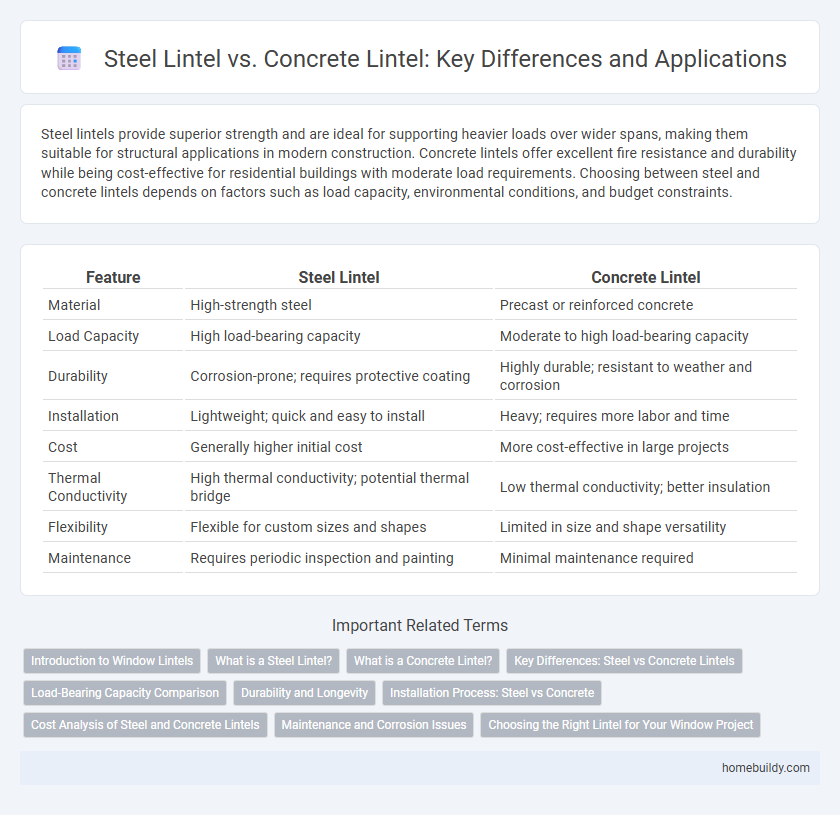Steel lintels provide superior strength and are ideal for supporting heavier loads over wider spans, making them suitable for structural applications in modern construction. Concrete lintels offer excellent fire resistance and durability while being cost-effective for residential buildings with moderate load requirements. Choosing between steel and concrete lintels depends on factors such as load capacity, environmental conditions, and budget constraints.
Table of Comparison
| Feature | Steel Lintel | Concrete Lintel |
|---|---|---|
| Material | High-strength steel | Precast or reinforced concrete |
| Load Capacity | High load-bearing capacity | Moderate to high load-bearing capacity |
| Durability | Corrosion-prone; requires protective coating | Highly durable; resistant to weather and corrosion |
| Installation | Lightweight; quick and easy to install | Heavy; requires more labor and time |
| Cost | Generally higher initial cost | More cost-effective in large projects |
| Thermal Conductivity | High thermal conductivity; potential thermal bridge | Low thermal conductivity; better insulation |
| Flexibility | Flexible for custom sizes and shapes | Limited in size and shape versatility |
| Maintenance | Requires periodic inspection and painting | Minimal maintenance required |
Introduction to Window Lintels
Window lintels provide critical structural support above openings in walls, preventing load from causing cracks or collapse. Steel lintels offer high tensile strength, durability, and ease of installation, making them ideal for modern constructions with heavy loads. Concrete lintels, often reinforced with steel bars, provide excellent compressive strength and fire resistance, suitable for traditional masonry buildings.
What is a Steel Lintel?
A steel lintel is a horizontal structural support made from steel, designed to bear the load above window or door openings in buildings. It offers high tensile strength, durability, and can span longer distances compared to concrete lintels, making it ideal for heavy loads and larger openings. Steel lintels are often galvanized or coated to prevent corrosion, ensuring longevity in various construction environments.
What is a Concrete Lintel?
A concrete lintel is a horizontal structural element made from reinforced concrete designed to support the load above window or door openings. It distributes weight evenly to prevent cracks and structural damage in masonry walls. Compared to steel lintels, concrete lintels offer enhanced fire resistance and can be custom-cast to fit specific architectural requirements.
Key Differences: Steel vs Concrete Lintels
Steel lintels offer superior tensile strength and flexibility, making them ideal for longer spans and heavy loads, while concrete lintels excel in compression and fire resistance. Steel lintels are typically lighter and quicker to install but may require protective coatings to prevent corrosion, whereas concrete lintels provide inherent durability and thermal mass. Cost efficiency varies depending on project scale, with steel lintels often favored in modern construction for adaptability, and concrete lintels preferred in traditional builds for their robustness.
Load-Bearing Capacity Comparison
Steel lintels exhibit higher load-bearing capacity compared to concrete lintels due to their superior tensile strength and flexibility under stress. Concrete lintels, although strong in compression, often require reinforcement such as steel bars to handle significant loads and prevent cracking. Structural engineers frequently select steel lintels for applications demanding greater durability and load performance in window openings.
Durability and Longevity
Steel lintels exhibit superior durability and longevity compared to concrete lintels due to their high tensile strength and resistance to cracking under load. Unlike concrete lintels, which can suffer from spalling and degradation over time when exposed to moisture and temperature fluctuations, steel lintels maintain structural integrity with minimal maintenance. Properly coated steel lintels also offer excellent corrosion resistance, ensuring extended service life in various environmental conditions.
Installation Process: Steel vs Concrete
Steel lintels offer a faster installation process due to their lighter weight and prefabricated design, requiring minimal on-site modifications and less curing time compared to concrete lintels. Concrete lintels require formwork, reinforcement placement, pouring, and curing, which significantly extends the installation timeline and labor effort. Steel lintels provide immediate structural support upon installation, whereas concrete lintels achieve full strength only after the curing period, typically 7 to 28 days.
Cost Analysis of Steel and Concrete Lintels
Steel lintels generally have higher initial costs compared to concrete lintels due to material and fabrication expenses, but they offer faster installation and reduced labor costs. Concrete lintels tend to be more cost-effective for standard openings, with lower material costs and simple onsite casting, yet may incur higher labor costs and longer curing times. Evaluating total project expenses, including lifecycle maintenance and structural requirements, is essential for accurate cost analysis between steel and concrete lintels.
Maintenance and Corrosion Issues
Steel lintels require regular maintenance to prevent corrosion, especially in environments exposed to moisture or salt, which can compromise structural integrity over time. Concrete lintels generally offer better resistance to environmental factors with minimal upkeep, as they do not rust but may suffer from cracking or spalling under extreme conditions. Applying protective coatings to steel lintels and ensuring proper drainage can significantly extend their lifespan compared to concrete counterparts.
Choosing the Right Lintel for Your Window Project
Steel lintels offer superior strength and flexibility for window projects requiring long spans or heavy loads, making them ideal for modern construction demands. Concrete lintels provide excellent durability and fire resistance, suitable for traditional builds with moderate load requirements and budget constraints. Selecting the right lintel depends on factors such as structural load, environmental conditions, aesthetic preferences, and cost efficiency.
steel lintel vs concrete lintel Infographic

 homebuildy.com
homebuildy.com